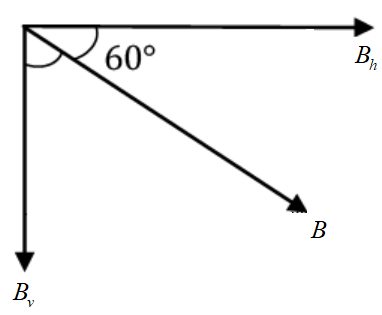
An aeroplane, with its wings spread 10 m, is flying at a speed of \[180\]km/h in a horizontal direction. The total intensity of earth's field at that part is \[2.5 \times {10^{ - 4}}{\text{ Wb/}}{{\text{m}}^2}\], and the angle of dip is \[{60^o}\]. The emf induced between the tips of the plane wings will be:
A. \[88.37\]mV
B. \[62.50\]mV
C. \[54.125\]mV
D. \[108.25\]mV
Answer
221.1k+ views
Hint:Here, in this question we need to determine the induced emf between the tips of the wings of the aeroplane. For this, we will use the formula of induced emf using scalar triple products such as magnetic field, length and velocity.
Formula used:
The emf induced by movement with respect to the magnetic field is,
\[e = \left[ {\vec B\vec V\vec L} \right]\]
\[e = BVL \times \sin \theta \]
where,
\[e\] is the induced emf, \[B\] is the magnetic field, \[V\] is the velocity of an object, \[L\] is the length and \[\theta \] is the angle between \[V\] and \[B\].
Complete step by step solution:
We know that the induced emf between the tips of the plane wings is,
\[e = \left[ {\vec B\vec V\vec L} \right]\]
Let us use the formula for the scalar triple product of vectors.
We know that \[\left[ {\vec a\vec b\vec c} \right] = ab \times \sin \theta \]
Accordingly, the induced emf is given by, \[e = B \times V \times L \times \sin \theta \].
We know that \[V = 180\]km/h, \[\theta = {60^o}\], \[B = 2.5 \times {10^{ - 4}}{\text{ Wb/}}{{\text{m}}^2}\], and \[L = 10\]m.
Here, we need to change the velocity in metre per seconds as-
\[v = \dfrac{{180 \times 1000}}{{60 \times 60}} \\
v= 180 \times \dfrac{5}{{18}}\,{\text{m/sec}} \\ \]
By substituting these values in the above formula, we get
\[e = 2.5 \times {10^{ - 4}} \times \left( {180 \times \dfrac{5}{{18}}} \right) \times 10 \times \sin \left( {{{60}^o}} \right)\]
Thus, after simplification, we get
\[e = 108.25 \times {10^{ - 3}}{\text{ }}V\]
\[\therefore e = 108.25{\text{ m}}V\]
Therefore, the emf induced between the tips of the wings of an aeroplane is \[108.25{\text{ }}mV\].
Hence, the option (D) is correct.
Note:Here is one more concept of solving this question. We can also write the formula of emf as \[e = {B_v}vl\] where \[{B_v}\] is the vertical component of the magnetic field.

Image: vector representation of scalar product
So,
\[{B_v} = B\sin 60 \\
{B_v} = \dfrac{{\sqrt 3 B}}{2} \\ \]
Now, substituting the known parameters in the formula \[e = {B_v}vl\] as-
\[e = {B_v}vl \\
\Rightarrow e= \dfrac{{\sqrt 3 }}{2} \times 2.5 \times {10^{ - 4}} \times \left( {180 \times \dfrac{5}{{18}}} \right) \times 10 \\
\therefore e= 108.25\,mV \]
Formula used:
The emf induced by movement with respect to the magnetic field is,
\[e = \left[ {\vec B\vec V\vec L} \right]\]
\[e = BVL \times \sin \theta \]
where,
\[e\] is the induced emf, \[B\] is the magnetic field, \[V\] is the velocity of an object, \[L\] is the length and \[\theta \] is the angle between \[V\] and \[B\].
Complete step by step solution:
We know that the induced emf between the tips of the plane wings is,
\[e = \left[ {\vec B\vec V\vec L} \right]\]
Let us use the formula for the scalar triple product of vectors.
We know that \[\left[ {\vec a\vec b\vec c} \right] = ab \times \sin \theta \]
Accordingly, the induced emf is given by, \[e = B \times V \times L \times \sin \theta \].
We know that \[V = 180\]km/h, \[\theta = {60^o}\], \[B = 2.5 \times {10^{ - 4}}{\text{ Wb/}}{{\text{m}}^2}\], and \[L = 10\]m.
Here, we need to change the velocity in metre per seconds as-
\[v = \dfrac{{180 \times 1000}}{{60 \times 60}} \\
v= 180 \times \dfrac{5}{{18}}\,{\text{m/sec}} \\ \]
By substituting these values in the above formula, we get
\[e = 2.5 \times {10^{ - 4}} \times \left( {180 \times \dfrac{5}{{18}}} \right) \times 10 \times \sin \left( {{{60}^o}} \right)\]
Thus, after simplification, we get
\[e = 108.25 \times {10^{ - 3}}{\text{ }}V\]
\[\therefore e = 108.25{\text{ m}}V\]
Therefore, the emf induced between the tips of the wings of an aeroplane is \[108.25{\text{ }}mV\].
Hence, the option (D) is correct.
Note:Here is one more concept of solving this question. We can also write the formula of emf as \[e = {B_v}vl\] where \[{B_v}\] is the vertical component of the magnetic field.

Image: vector representation of scalar product
So,
\[{B_v} = B\sin 60 \\
{B_v} = \dfrac{{\sqrt 3 B}}{2} \\ \]
Now, substituting the known parameters in the formula \[e = {B_v}vl\] as-
\[e = {B_v}vl \\
\Rightarrow e= \dfrac{{\sqrt 3 }}{2} \times 2.5 \times {10^{ - 4}} \times \left( {180 \times \dfrac{5}{{18}}} \right) \times 10 \\
\therefore e= 108.25\,mV \]
Recently Updated Pages
[Awaiting input: Please provide the content from "Ask AI Response," "Competitor 1," and "Competitor 2," so I can perform the analysis and synthesize the requested metadata and headings.]

Young’s Double Slit Experiment Derivation Explained

A square frame of side 10 cm and a long straight wire class 12 physics JEE_Main

The work done in slowly moving an electron of charge class 12 physics JEE_Main

Two identical charged spheres suspended from a common class 12 physics JEE_Main

According to Bohrs theory the timeaveraged magnetic class 12 physics JEE_Main

Trending doubts
JEE Main 2026: Application Form Open, Exam Dates, Syllabus, Eligibility & Question Papers

Understanding Uniform Acceleration in Physics

Derivation of Equation of Trajectory Explained for Students

Hybridisation in Chemistry – Concept, Types & Applications

Understanding the Angle of Deviation in a Prism

How to Convert a Galvanometer into an Ammeter or Voltmeter

Other Pages
JEE Advanced Marks vs Ranks 2025: Understanding Category-wise Qualifying Marks and Previous Year Cut-offs

Dual Nature of Radiation and Matter Class 12 Physics Chapter 11 CBSE Notes - 2025-26

Degree of Dissociation: Meaning, Formula, Calculation & Uses

Ideal and Non-Ideal Solutions Explained for Class 12 Chemistry

Understanding the Electric Field of a Uniformly Charged Ring

Understanding Electromagnetic Waves and Their Importance




